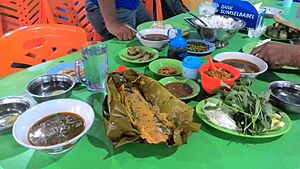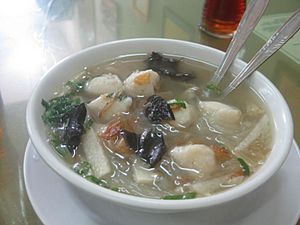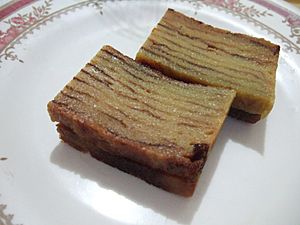Palembang cuisine facts for kids
Palembangese cuisine is the delicious food from the city of Palembang in South Sumatra, Indonesia. It is one of the most famous types of food from the island of Sumatra, right after Padang food.
Contents
What's in Palembang Food?
Palembang food mostly uses freshwater fish and prawns. This is because the Musi River is very important to the area. Some popular freshwater fish include patin (a type of Pangasius), baung (Hemibagrus), lais (Kryptopterus cryptopterus), lele (catfish), gabus (snakehead), mas (carp), and gurame (gourami).
Long ago, the waters around Palembang were full of belido (giant featherback) fish. This fish even became the city's official animal mascot! People loved it because it tasted great and had a soft texture. Sadly, too many belido fish were caught. Now, they are very rare and might even be gone from the Musi River.
Since Palembang is also close to the sea, seafood is popular too. You can find dishes with shrimp, tenggiri (wahoo), kakap merah (red snapper), and Spanish mackerel. Besides fish dishes, Palembang cuisine also has many kinds of snacks, drinks, and sweets.
Flavors and Spices
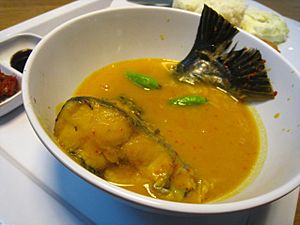
Palembang food uses spices, but not as much as some other Indonesian foods. It is known for its sweet and sour tastes. You can see this in pindang fish soup. There's also tempoyak, which is a dish made from fermented durian fruit. It has a unique smell! Another example is kuah cuko, a spicy-sweet vinegar sauce that goes with pempek fishcakes. These dishes are very popular and are often linked to Palembang city.
Food Influences
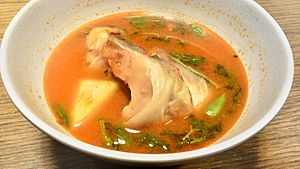
Palembang's food has been shaped by different cultures. These include Malay, Javanese, Arab, Indian, and Chinese traditions.
For example, pempek, tekwan, and mie celor show Chinese influences. Pempek is a fishcake made from fish and tapioca flour. It's like a local version of East Asian surimi fishcakes. Many noodle dishes in Indonesia, including mie celor, also have Chinese roots.
People believe that Palembang's love for sweet flavors comes from Javanese influences. Javanese food often uses palm sugar. Palembang has adopted many things from Javanese traditions, including language and food. For instance, both Javanese and Palembang Malay dialects call fish iwak. Also, a cooking method where food is wrapped in banana leaves is called brengkes or brengkesan in both cultures.
Martabak Palembang and nasi minyak use ghee (a type of clarified butter). These dishes show the influence of Indian food in the city.
Popular Palembang Dishes
Palembang dishes are famous for using lots of freshwater fish. They also make surimi-like fishcakes for many recipes. Sweet palm sugar, coconut milk, vinegar, or tamarind are often used for flavor. Here are some favorite Palembang foods:
- Pempek: This is probably the most famous Palembang dish. It's a dough made from fish and tapioca flour. You can boil, fry, or grill it. It's eaten with a dark, sweet, and spicy sauce called Cuko. This sauce is made from palm sugar and chili pepper. It's often topped with cucumber and prawn powder.
- Pempek comes in many shapes and sizes. Some examples are lenjer (long), keriting (curly), kapal selam (like a "submarine," filled with egg), ada`an (round and fried), and pistel (filled with cooked young papaya).
- Real pempek is traditionally made from giant featherback (Chitala lopis) fish. But because this fish is now rare, it can also be made with other fish like striped snakehead (Channa striata), narrow-barred Spanish mackerel (Scomberomorus commerson), or snappers (Lutjanus sp.).
- Tekwan: These are small pempek balls served in a fresh prawn soup. They come with cellophane noodles and ear mushrooms. Many people think of tekwan as Palembang's version of bakso (meatball soup).
- Model: This is a type of pempek filled with tofu. It's served with fresh prawn soup and cellophane noodles (called model iwak). Sometimes, the pempek part is replaced with fried bread (called model gendum).
- Laksan: These are thick slices of pempek lenjer. They are served with a spicy coconut milk sauce and prawn powder.
- Celimpungan: This dish is similar to laksan, but it uses large tekwan balls instead of sliced pempek. It has a rich coconut milk gravy. This thick sauce is cooked with turmeric, pepper, and bay leaves.
- Mie Celor: This dish has yellow noodles, like Japanese soba. They are served with coconut milk, prawns, and a boiled egg.
- Burgo: These are folded pancakes made from rice flour. They are sliced and served with a whitish coconut milk soup. The soup can have snakehead fish or powdered prawns.
- Lakso: This is similar to burgo. But lakso is made of thick rice noodles, and its soup is yellowish from turmeric.
- Ragit: This bread looks like Roti Jala, a famous Malay dish. Ragit can be a triangle roll or look like an omelet. It's served with a curry soup made from curry, coconut milk, meat, and potato. Ragit curry soup is often topped with fried onion and chopped green chili. You can usually find ragit during the Ramadhan month.
- Martabak HAR: This is an egg-murtabak (a type of stuffed pancake). Eggs are added to the flattened dough before it's folded and fried. It's served with curry (usually beef curry with diced potatoes) and topped with chilies in a sweet-sour soy sauce. An Indian Indonesian named Haji Abdul Rozak made it popular in Palembang on July 7, 1947. That's why it has his initials in its name!
- Nasi minyak (Palembang Malay for "oily rice"): This Sumatran dish is rice cooked with minyak samin (ghee) and spices.
- Pindang Patin: This is a spicy soup with iridescent shark (Pangasianodon hypophthalmus). It's boiled with spices and usually served hot with sliced pineapple.
- Pindang Tulang: This is a spicy soup with beef ribs. It's boiled with spices, just like pindang patin. This dish tastes savory, spicy, and sour.
- Malbi: This is a beef stew cooked with sweet soy sauce and spices. It's often served during Eid al-Fitr or at traditional Palembang weddings. A serving of Malbi usually comes with nasi minyak, which is rice cooked with ghee oil and spices.
- Tempoyak: This is fermented durian fruit stir-fried with onion and chili pepper.
- Brengkes Tempoyak Ikan Patin: This dish is iridescent shark and tempoyak steamed with spices.
- Otak-otak: This is minced freshwater fish mixed with tapioca flour, coconut milk, and spices. It's then grilled while wrapped in a banana leaf.
Tasty Snacks
- Kemplang: These are thin slices of pempek lenjer that are dried in the sun. Then, they are grilled or fried.
- Kerupuk: These are similar to kemplang. But the pempek dough is made into a swirly shape and then fried.
Refreshing Drinks
- Es Kacang Merah: This is shaved ice served with red kidney beans. The beans are soaked and boiled first. It also has syrups, avocado, and sweet condensed milk.
Sweet Desserts
- Kue Maksuba: This is a layered cake made mostly with duck eggs and sweetened condensed milk, without any flour. Each cake needs more than two dozen duck eggs! The cake batter is poured in thin layers into a square pan and baked layer by layer. This cake was originally a royal sweet from the Palembang Sultanate Palace. It was served to important guests. Today, many Palembang people serve it during special ceremonies or during Eid al-Fitr and sometimes Eid al-Adha.
- Kue Delapan Jam: This cake has similar ingredients to Kue Maksuba, also without flour and using eggs as the main ingredient. But it's not layered. This cake is called "eight hours cake" because it needs to be steamed for 8 hours! It has a lot of condensed milk, making it very sweet. To cook it perfectly, it must be steamed on a low heat for eight hours straight. This cake is also often served to important guests, during special ceremonies, or during Eid al-Fitr and sometimes Eid al-Adha.
- Kue Bolu Kojo: This is a green sweet cake. Its main ingredients are eggs, sweet condensed milk, and pandan leaves. Unlike Kue Maksuba and Kue Delapan Jam, this cake uses wheat flour. It is served to important guests, during special ceremonies, or during Eid al-Fitr and sometimes Eid al-Adha.
- Kue Srikayo: This is a steamed dessert made with eggs and pandan leaves. It's usually served with sticky glutinous rice.
- Engkak Ketan: This sweet cake is one of the oldest traditional cakes from Palembang. It's made from coconut milk, eggs, milk, and glutinous rice flour. The result is a moist and sweet cake. Engkak Ketan is usually served during Eid al-Fitr as part of cultural traditions.


